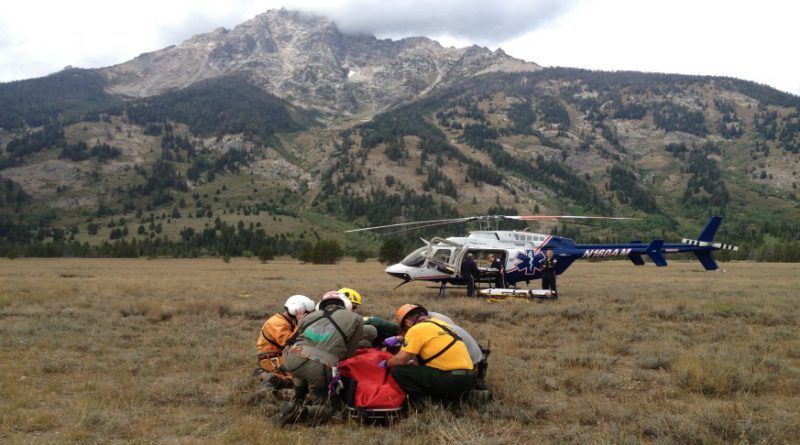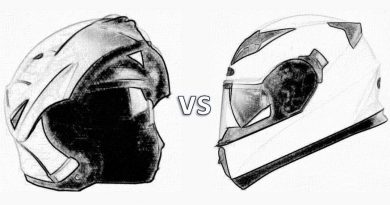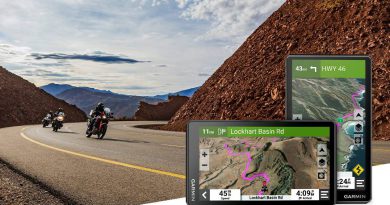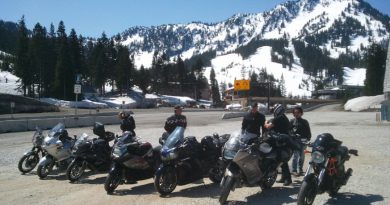Satellite Locator Beacons Explained
There are times when we all want to take a long ride alone. Solo. Our route, our timetable, our stops. Every motorcycle rider dreams about experiencing the ultimate freedom of being alone on the open road. No one else to keep track of and only yourself to depend on. That’s when one truly appreciates the full freedom of motorcycling.
It’s important to emphasize that part about “only yourself to depend on”. What happens if something goes wrong? Being prepared and carrying along essential gear are critical. Most of the time a few tools and a tire repair kit are all that’s needed to get out of a jam. But when a rider goes down in a remote area, there’s only one reliable way to call for help – a satellite-based personal locator beacon.
This article focuses on purpose-built personal locator beacons. Apple iPhones and the Garmin XT2 navigator now offer a built-in SOS service as well. Both enable sending a distress signal using the satellite system described here. And like purpose-built devices, both require a paid subscription after the trial period ends. It may be more convenient and cheaper to rely on a mobile phone or navigator rather than investing in an additional device, but it’s worth considering that companies like Ocean Signal are 100% dedicated to assisting rescue teams locate individuals in distress. It’s their core business.
Personal Locator Beacon or Satellite Messenger
Personal locator beacons, sometimes called emergency beacons, are designed to do one thing – summon help from virtually anywhere in the world in a life-threatening emergency, regardless of cell coverage. While it’s true the vast majority of riders carry a cell phone and rely on GPS to make their way through backroads and occasionally even forest roads, it’s also true that neither device is much help when a rider has a problem in a remote area. Yes, carriers continue to expand network coverage and newer devices include an SOS feature; still, some of the most popular motorcycle roads remain without cell service. If an incident occurs on one of those roads, a personal locator beacon could mean the difference between lifesaving emergency help and an eternal wait.
For comparison, satellite messengers offer one-way and two-way messaging features along with the same distress signal capability built into personal locator beacons. Unlike cell phones however, satellite messengers use a satellite network to transmit and receive messages enabling them to work pretty much anywhere on earth. At a minimum, satellite messengers can send text messages. Higher end models offer two-way texting and voice calls. Beyond comms, features might also include location tracking, location signaling, and navigation to name a few. The drawback however is that unlike a personal locator beacon, satellite messengers require a monthly or annual subscription to operate.
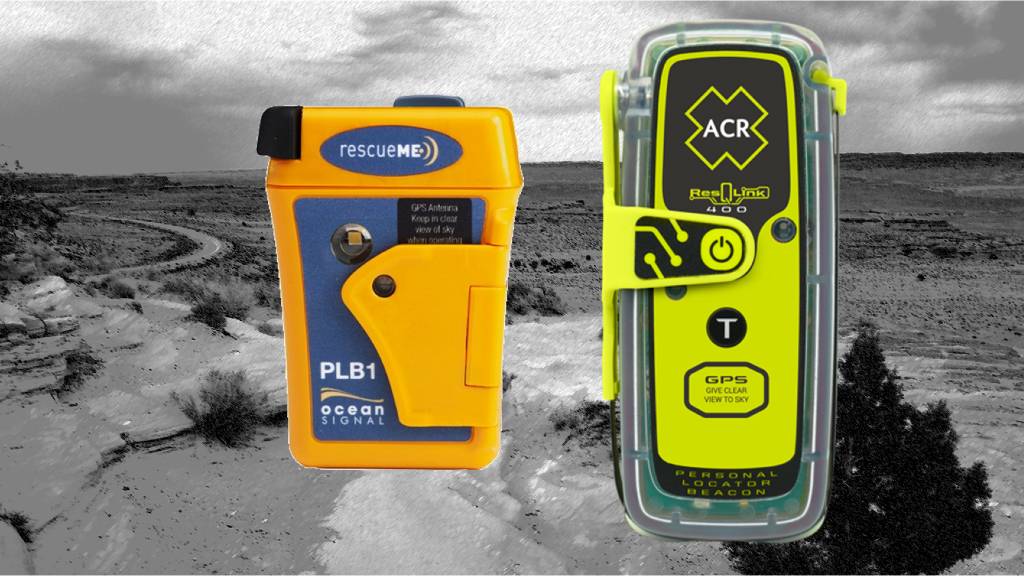
Solo riders need an extra measure of safety before heading out alone to explore the open roads. A personal locator beacon is a sensible step in that direction. Personal Locator Beacons are purpose-built and backed by manned 24/7 monitoring stations who are ready to dispatch help.
The remainder of this article focuses on Personal Locator Beacons.
How Personal Locator Beacons Work
Before jumping into product selection criteria, it might help to have a basic understanding of the underlying technology that makes a personal locator beacon work.
Personal locator beacons are small pocketable devices that use a specific radio frequency to dispatch a distress signal when activated. The important point being “when activated”. Unlike aircraft and marine distress signals that automatically activate in water or on impact, personal locator beacons must be manually activated. Until that happens the device remains in standby. That may seem like a drawback, and in severe situations it may be, but being able to reach for a locator beacon can mean surviving to ride again. Beacons are a measure of safety and preparedness that riders touring in remote areas should not overlook.
SARSAT (Search and Rescue Satellite Aided Tracking) is a system of three satellite networks which together form the backbone used by personal locator beacons to connect a person in distress with local search and rescue teams. The system and related services operate under an international consortium, of which the United States is a founding member; (other founding members are Canada, France, and Russia). While initially intended for maritime and aviation search and rescue, the availability of low cost personal locator beacons has made the service accessible to virtually anyone anywhere on the planet.
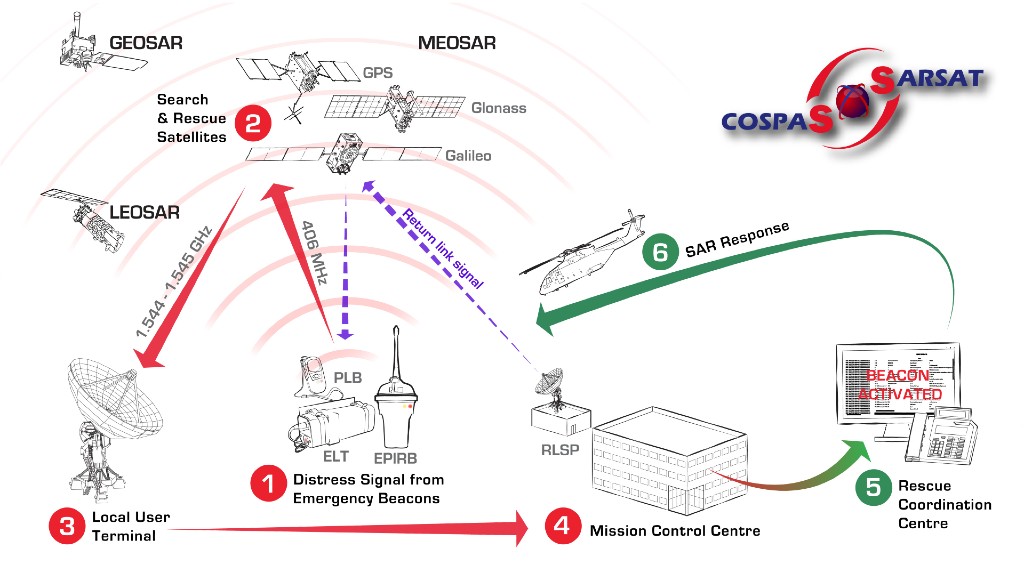
When activated in an emergency situation, a personal locator beacon transmits a message to the nearest group of SARSAT satellites which in turn relay the information to ground stations connected to a regional Mission Control Center (there are 6 of these globally). There, Mission Control Center personnel process the information and notify local rescue teams. The locator beacon message contains the beacon’s unique ID and may contain other data such as GPS coordinates. Assuming the device is registered, the Mission Control Center will match the beacon ID to previously registered emergency information to further aid rescue workers.
The National Oceanic and Atmospheric Administration (NOAA) manages the SARSAT service on behalf of the United States. There is no fee to register a beacon and there is no charge for dispatching local search and rescue. That said, emergency service providers may try to recover their costs depending on the particular circumstances of the emergency.
NOAA requires personal locator beacon owners to do a few things. First, register the device so that in the event of an emergency the Mission Control Center can match it to a person and their emergency information. Second, keep registration data current by refreshing the information every two years. And finally, if the device is sold or given away be sure to update the device registration to show a change of ownership; until that happens the new owner cannot register the device.
What Beacon to Buy?
Selecting a personal locator beacon is in many ways a surprisingly simple process; there aren’t that many decisions to make. First of all, every beacon on the market must meet mission-critical performance criteria. These include: a) the ability to transmit a distress message at 406 MHz; b) the ability to emit a 121.5 MHz homing signal to assist on-site search and rescue; c) once activated, battery power sufficient to send a continuous signal for at least 24 hours; and, d) a switch to manually trigger a distress signal.
The distress message sent from all personal locator beacons includes the beacon’s unique ID and may include other encoded data depending on device features. Ground stations compute the approximate device location to within 2 square kilometers using multiple SARSAT satellite signals.
Features beyond these required capabilities are useful and make up the differentiators on which to select a beacon. Here are a few important features to consider.
Certification – This goes without saying, but it’s always a good idea to confirm that the beacon you select is certified by COSPAS-SARSAT; (COSPAS is the Russian acronym for their contribution to the international system). Certification assures you the device meets required minimum standards (e.g. signal frequency).
GPS Coordinates – Although not required by SARSAT, most personal locator beacons include a GPS receiver to compute precise location coordinates and then include them in the distress message. Having on-device GPS capability improves location precision to within 100 meters versus 2km otherwise.
Stand-by Battery Life – The battery in a quality beacon should last at least 5 years. Remember, the device remains powered off, with no draw on the battery until activated in an emergency or during a self-test. In most cases the device must be returned to the manufacturer for a replacement battery.
Water Resistance – At a minimum, a good beacon continues working when submerged in up to 5 meters of water (a little more than 16 feet); some can go as deep as 15 meters. Many include a floatation pouch. Some riders may find the flotation pouch too bulky to comfortably carry the beacon in a coat or pants pocket where it can be easily reached in an emergency. Water resistance is what matters, the flotation pouch is unnecessary.
Strobe Light – GPS coordinates are accurate to within 100 meters, and in practice often exceed that. Even so, a strobe light that activates when the emergency signal is sent, greatly helps search and rescue locate a down rider.
Self-test Capability – It’s good to know the beacon works and has sufficient remaining battery life before an actual emergency arises. Built-in self-test features confirm the beacon is working and the remaining battery level. Be sure to follow the manufacturer’s self-test instructions to avoid sending a false emergency signal. Devices that do not have a self-test feature must be brought to a dealer for testing. Also keep in mind that once an emergency signal is sent, there’s no way to call it back. Check the NOAA FAQ site (see reference below) for information on how to report a false emergency signal.
Brand & Warranty – Ok, these are not exactly features, but brand and warranty are important differentiators. In the world of personal locator beacons designed for broad consumer use, there are only two brands to consider. They are ACR Electronics and Ocean Signal. Other well-known brands, for example SPOT and Garmin, do not offer personal locator beacons. Their products fall into the satellite messenger category. Warranties on these products range from 5 to 7 years, and provide for repair or replacement.
Size & Weight – Since most users will carry the beacon in a coat or pants pocket, it’s important that the product be comfortably compact. Depending on the feature set, units range from about the size of a deck of cards (3”x2”x1”) to as large as 4.5”x2”x1.5”. A beacon typically weighs between a quarter and a third of a pound.
Price – The cost of a personal locator beacon runs between $300 and $400. No further subscription or service costs are required. For comparison, satellite messengers require an upfront $200 to $300 device purchase, and an on-going subscription fee that ranges from $12 per month to $50 per month depending on messaging features.
Peace of Mind Knowing Help is in Reach
Select a personal locator beacon that best meets your needs. Register it with NOAA and keep your registration up to date. Periodically run a self-test and ideally test before a long ride. Always carry the beacon on your person not on the bike. And of course, know when and how to trigger an actual emergency call.

Whether riding alone or in a group, a personal locator beacon provides a vital link to emergency help from virtually anywhere in the world. This small bit of gear requires almost no attention but can mean survival even on the most remote roads.
Did we hit the mark?
Click the Thumbs Up or Thumbs Down button to email your feedback.
Your questions and comments help improve American Sport Touring. Your email is not used for any other purpose. Please read our Privacy Policy.
References & Resources
| Site | Link |
|---|---|
| NOAA Beacon Registration & registration updates | https://www.sarsat.noaa.gov/beacon.html |
| NOAA SARSAT Frequently Asked Questions with references to useful resources | https://www.sarsat.noaa.gov/faq 2.html |
| Overview Presentation on COSPAS-SARSAT | https://www.sarsat.noaa.gov/SARSAT 101 Brief PDF.pdf |
| Locator beacons from ACR Electronics | https://www.acrartex.com/ |
| Locator beacons from Ocean Signal | https://oceansignal.com/ |

